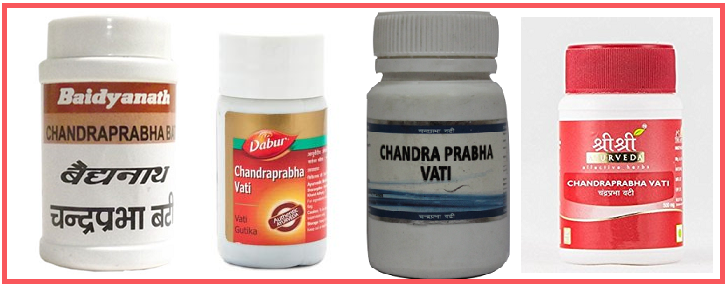What is Divya Chandraprabha Vati
Divya Chandraprabha vati is a ayurvedic medicine by baba ramdev to supports urinary system and immune system it also promotes strength and nourishment to the body in all ways.
According to top ayurveda gurus Divya Chandraprabha Vati nourishes tissue elements (rasa, rakta, etc.) from weakness ( emaciation ), paleness of body, suppression of the power of digestion, dyspnoea caused by little effort shrunken eyes; anorexia (loss of appetite); alleviates vayu and makes the body lustrous as well as splendorous after nourishing it.

What is the main disease indication this is used for?
Although traditionally was used for various types of Kapha disorders. But now is also used in the maintenance of healthy urinary tract & giving strength to over all body, Supports the proper functioning of reproductive system. Promotes balanced blood sugar levels. Helps to relieve burning urination.
Chandraprabha Vati uses
It is used in Ayurvedic treatment of urinary tract infection, difficulty in urination, urinary calculi.
It helps to relieve constipation, bloating, abdominal colic pain, low back pain.
It is useful in treating cold, cough, rhinitis, bronchitis, asthma and such other respiratory diseases.
It is used to treat eczema, dermatitis, pruritus and allergic skin conditions.
It is useful to treat piles, liver, spleen diseases, anaemia and fistula.
It helps to relieve teeth problems like caries, eye infections.
It is used to treat semen defects and gynaecological problems.
It helps to relieve indigestion, improves strength, it is a natural aphrodisiac and anti aging Ayurvedic medicine.

Ingredients
Herbs in Chandraprabha Vati
| SCIENTIFIC NAMES | COMMON NAME |
| 3 grams each: | – |
| Aconitum heterophyllum | Ativisha |
| Acorus Calamus | Sweet Flag or Calamus or Vacha |
| Andrographis paniculata | Bhunimba |
| Berberis aristata | Tree Turmeric |
| Cedrus Deodara | Himalayan Cedar bark, Devdaru |
| Coriandrum sativum | Coriander seeds |
| Curcuma Longa | Turmeric, Haldi |
| Cinnamomum Camphora | Camphor (Kapur) |
| Cyperus rotundus | Nut grass (root) or Mustak |
| Embelia ribes | False black pepper (Vidang) |
| Emblica officinalis | Indian gooseberry fruit (Amla) |
| Piper Chaba Seeds | Java Long Pepper, Chavya |
| Piper Chaba Fruit | Java Long pepper fruit, Gajapipali |
| Piper Longum | Long pepper (Pippali) |
| Piper Longum | Long Pepper root (Piplamool) |
| Piper Nigrum | Black pepper (Kali Mirch) |
| Plumbago zeylanica | Lead Wort (root), Chitraka |
| Tinospora cordifolia (Guduchi) | Giloy |
| Terminalia Chebula | Chebulic Myrobalan, Haritaki |
| Terminalia Bellirica | Belliric Myrobalan, Vibhitaki |
| Zingiber Officinale | Ginger, Shunti |
| – | – |
| 12 grams Each: | – |
| Baliospermum montanum | Dantimool |
| Bambusa bambos | Bamboo manna, Banslochan |
| Cinnamomum tamala | Patra |
| Cinnamomum zeylanicum | Cinnamon |
| Elettaria cardamomum | Cardamom seeds |
| Operculina turpethum | Trivrit |
| 96 grams Each: | |
| Commiphora mukul | Shuddha Guggulu |
Study of Ingredients
Aconitum Heterophyllum
Aconitum heterophyllum is harvested for its tubers. These tubers constitute the Ayurvedic plant drug “Ativisa” which is included in the Ayurvedic Formulary of India. During collection the whole plant is uprooted. It has been observed, as well as inferred, that the trend of unsustainable collection practice is continuing. Inference has been drawn regarding the decline in area of occupancy (AOO) and habitat quality based on observations, as well as circumstantial evidence. The species has sizeable market demand on account of its commercial use as a plant drug and the level of exploitation is high. In the CAMP workshop organised at Shimla in 2003 it was collectively agreed by the experts that c. 70% of the wild population in India had declined over the previous ten years. The species was therefore assessed as Endangered (EN). As the situation has not improved, the same status is still valid (D. Ved, D. Saha, K. Ravikumar and K. Haridasan pers. comm. 2015). This species is endemic to the Himalayan region extending from northern Pakistan, the Indian State of Jammu and Kashmir, Himachal Pradesh, Uttarakhand (India) and further up to Nepal. Thus the majority of the wild population is in the Indian Himalaya. The situation in India is therefore considered representative of the global population of the species.
Terminalia Bellirica
The Medicinal plant Terminalia bellerica also known as Baheda is native to India and grows throughout the country especially in lower hill areas. The plant grows up to 60-80 feet height. The trunk is straight and dark brown in colour. The leaves are broad, oval and 4-8 inches long. Leaves are crowded towards the end of the branch and tips are pointed. The flowers grow in both upper and lower part. The upper flowers are male and lower flowers are bisexual. When the fruit dries, it looks like a pentagon and is fibrous. In Sanskrit, it is called as ‘Vibheeta,’ which actually means the one which takes away the fear of disease.
Minerals in Chandraprabha Vati
| Common Name | Other names |
| 3 grams each: | – |
| Swarnmashik Bhasma | – |
| Hordeum Vulgare Salt | Yava Kshara (Barley salt) |
| – | Swarjika Kshara (Sajji Kshara) |
| Rock Salt | Saindhava Lavana |
| Sochal Salt | Savvarchala Lavana |
| Vida Salt | Vida Lavana |
| 24 grams each: | – |
| Loha Bhasma | Iron Bhasma |
| 96 grams each: | – |
| Asphaltum Punjabianum | Shilajit (Shilajatu) |
Traditional Indications
Prameha – Urinary tract disorders, diabetes
Prameha is a syndrome described in the ancient Ayurvedic texts that includes clinical conditions involved in obesity, prediabetes, diabetes mellitus, and metabolic syndrome. MATERIALS AND METHODS: Integrating the theory and modalities of Ayurveda in the management of these disorders may prove to be beneficial.
Mutrakrichra – dysuria, difficulty to pass urine
Mutraghata – urinary obstruction
Ashmari – urinary calculi
Vibandha – constipation
Anaha – bloating, gaseous distension of abdomen
Shoola – abdominal colic
Meha – urinary tract disorders, diabetes
Granthi – tumor, fibroid
Arbuda – cancer
Andavruddhi – orchitis
Pandu – Anemia, initial stages of liver disorders
Kamala – jaundice
Haleemaka – Liver cirrhosis
Antravruddhi – Hernia
Kati shoola – low back ache
Shwasa – asthma, respiratory disorders involving difficulty in breathing
Kasa – cold, cough
Vicharchika – eczema
Kushta – skin diseases
Arsha – Hemorrhoids
Kandu – itching
Pleehodara –splenomegaly, enlarged spleen
Bhagandhara – fistula in ano
Dantaroga – teeth disorders
Netraroga – eye disorders
Artavaruja – Painful periods, menorrhagia
Shukra Dosha – semen, sperm anomalies
Mandagni – low digestion strength
Aruchi – Anorexia, lack of interest in food
Balances Vata, Pitta and Kapha Dosha
Vrushya – aphrodisiac
Rasayani – anti aging, rejuvenative
Chandraprabha Vati Manufacturer
Chandraprabha Vati is a famous ayurvedic formulation which is made by nearly all ayurvedic companies like Zandu, Dabur, Baidnath Baidyanath, Shri Shri Surya herbals & other.
According to reviews available on internet Dabur & Divya products are working best to the said problems & are available easily in every city.
Chandraprabha Vati Price
Divya Chandraprabha Vati price in India is Rs. 40 to Rs. 105 based on paacking size on most of the online shop.
Chandraprabha Vati Packing
Divya Chandraprabha Vati comes in a pack of 20, 40 & 60 grams plastic container pack.
How to order?
You can order it online from many sites by searching on google which can be delivered to your home address in few days,
Another option is to purchase from your local shops please call Patanjali Customer Service at 01334 227 444 to know the address of retail outlet in your city.






